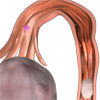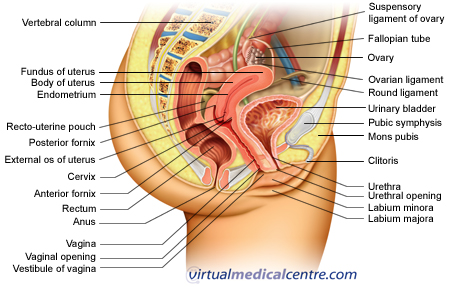The menstrual cycle continued
By week 3, the uterus has finished regenerating and is now entering the secretory phase, which will provide the ideal environment for implantation (embedding of the fertilised egg into the uterus) should fertilisation occur.
At the same time, in the ovary, the corpus luteum has formed and is producing oestrogen and progesterone, which support pregnancy if fertilisation occurs. Ovulation will have occurred at this stage, meaning that a mature ovum may be in the fallopian tubes and is potentially fertilisable, or the ovum may already have been fertilised by a sperm.
Fertilisation
Fertilisation is a complex sequence of molecular events that typically occurs in the fallopian tubes.
This process usually takes about 24 hours and involves:
- Attraction: The oocyte (unfertilised egg) sends out chemical signals to attract sperm to its location;
- Passage of a single sperm through the outer layers of the oocyte (the corona radiata and zona pellucida): This is achieved by enzymes contained in the sperm’s acrosome (head region). Once the sperm penetrates the zona pellucida, the properties of the outer layer are changed such that no other sperm are able to enter.
- Formation of the zygote: The genetic material contained within the egg (23 chromosomes) and sperm (23 chromosomes) fuse to create a single whole copy of genetic material for a human being (46 chromosomes). This is known as the zygote.
Development
Following fertilisation, the zygote continues to pass through the fallopian tube, where it undergoes a series of mitotic divisions (replication and cleavage) into smaller cells (blastomeres). By day 3, there are approximately 12 or more blastomeres, which make up a small ball-shaped mass called the morula. As the morula enters the uterus, a cavity forms within the morula, and it is now referred to as the blastocyst.
On days 4–5 following fertilisation (approximately 6 days into the luteal phase of the ovarian cycle, or about day 20 of a 28-day cycle) the outer layer of the blastocyst, the zona pellucida, is shed and the blastocyst attaches to and invades the endometrial lining. The site of implantation is variable and can even occur outside of the uterus (see ectopic pregnancy), but usually occurs on the upper back wall of the uterus.
By the end of the 3rd gestational week or the 1st week of pregnancy, the blastocyst is superficially implanted into the endometrial lining.
Pregnancy week by week
 |
To go back, see Gestational Week 2: Ovulation. |
More information
 |
For more information on foetal development and maternal changes during pregnancy, see Stages of Pregnancy. |
 |
For more information about pregnancy, including preconception advice, stages of pregnancy, investigations, complications, living with pregnancy and birth, see Pregnancy. |
References
- Moore KL, Persaud TVN. The Developing Human: Clinically oriented embryology (7th edition). Philadelphia: Saunders; 2003. [Book]
- Johnson LR, Byrne JH. Essential Medical Physiology (2nd edition). Philadelphia, PA: Lippincott Williams and Wilkins; 1998. [Book]
- Emans SJH, Laufer MR, Goldstein DP (eds). Pediatric and Adolescent Gynecology (5th edition). Philadalphia: Lippincott Williams & Wilkins; 2005. [Book]
All content and media on the HealthEngine Blog is created and published online for informational purposes only. It is not intended to be a substitute for professional medical advice and should not be relied on as health or personal advice. Always seek the guidance of your doctor or other qualified health professional with any questions you may have regarding your health or a medical condition. Never disregard the advice of a medical professional, or delay in seeking it because of something you have read on this Website. If you think you may have a medical emergency, call your doctor, go to the nearest hospital emergency department, or call the emergency services immediately.









